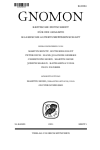Gnomon
Zusammenfassung
Der GNOMON pflegt als kritische Zeitschrift für die gesamte Altertumswissenschaft die Verbindung zwischen den verschiedenen Disziplinen der Altertumswissenschaft. Er nimmt dadurch eine Sonderstellung unter den Rezensionsorganen ein und bietet die Möglichkeit, sich über wichtige Forschungen und Publikationen auch in den Nachbarbereichen des eigenen Faches zu orientieren. Die Rezensionen im GNOMON wenden sich an ein internationales Publikum, das aus allen Teilgebieten der Altertumswissenschaft kommt. Die Publikationssprachen im GNOMON sind: Deutsch, Englisch, Französisch, Italienisch und Lateinisch.
Der GNOMON erscheint acht Mal im Jahr.
Abstract
As a critical journal for all classical studies, the GNOMON fosters the links between the distinct classical disciplines. It has thus an exceptional position among the classical review journals and allows familiarization with research and publications in neighbouring disciplines. The reviews address an international readership from all fields in classical studies. The GNOMON publishes reviews in German, English, French, Italian and Latin.
The GNOMON is published in eight issues a year.
- U1–U1 Titelei U1–U1
- 193–196 Emma M. Griffiths: Children in Greek Tragedy. Pathos and Potential. 193–196
- 196–201 David Charles: The Undivided Self. Aristotle and the ‘Mind-Body-Problem’. 196–201
- 201–204 Philodemus, On Poems. Book 2 with the fragments of Heracleodorus and Pausimachus edited with Introduction, Translation, and Commentary by Richard Janko. 201–204
- 205–209 Sara Lanna: Mesomede. Inno a Iside. Edizione con introduzione, traduzione, commento, e altri testi del culto isiaco. 205–209
- 209–212 Proclus, Commentaire sur le Parménide de Platon. Tome VII. Livre II. Par Concetta Luna et Alain-Philippe Segonds †. 209–212
- 212–215 Aline Estèves: Poétique de l’horreur dans l’épopée et l’historiographie latines. 212–215
- 215–224 Donncha O’Rourke (Ed.): Approaches to Lucretius. Traditions and Innovations in Reading the De Rerum Natura 215–224
- 224–226 Pline le Jeune, Lettres. Tome IV. Livre X. Texte établi, traduit et commenté par Hubert Zehnacker et Nicole Méthy. 224–226
- 227–230 Daniel Ogden: The Werewolf in the Ancient World. 227–230
- 230–235 John L. Friend, The Athenian Ephebeia in the Fourth Century BCE. 230–235
- 235–238 Michael Sommer: Schwarze Tage. Roms Kriege gegen Karthago. 235–238
- 239–245 Robert Morstein-Marx: Julius Caesar and the Roman People. 239–245
- 246–249 Katharina Bolle: Materialität und Präsenz spätantiker Inschriften. Eine Studie zum Wandel der Inschriftenkultur in den italischen Provinzen. 246–249
- 249–252 Caroline Sophia Kreutzer: Weisheit und Alter in der Spätantike. Die Konstruktion von sapientia und senectus bei Ambrosius von Mailand und Paulinus von Nola. 249–252
- 253–259 Serenella De Natale: Pontecagnano II.7. La necropoli del Picentino. Tombe della Prima Età del Ferro dalla proprietà Colucci. 253–259
- 259–264 Peter Stewart: A Catalogue of the Sculpture Collection at Wilton House. With new photography by Guido Petruccioli. 259–264
- 264–288 VORLAGEN UND NACHRICHTEN 264–288
- 290–317 Bibliographische Beilage Nr. 2 290–317


